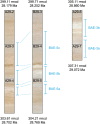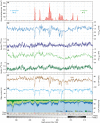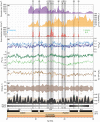Orbitally Forced Hyperstratification of the Oligocene South Atlantic Ocean
- PMID: 31058259
- PMCID: PMC6485903
- DOI: 10.1002/2017PA003222
Orbitally Forced Hyperstratification of the Oligocene South Atlantic Ocean
Abstract
Pelagic sediments from the subtropical South Atlantic Ocean contain geographically extensive Oligocene ooze and chalk layers that consist almost entirely of the calcareous nannofossil Braarudosphaera. Poor recovery and the lack of precise dating of these horizons in previous studies has limited the understanding of the number of acmes, their timing and durations, and therefore their likely cause. Here we present a high-resolution, astronomically tuned stratigraphy of Braarudosphaera oozes (29.5-27.9 Ma) from Ocean Drilling Program Site 1264 in the southeastern Atlantic Ocean. We identify seven episodes with highly abundant Braarudosphaera. Four of these acme events coincide with maxima and three with minima in the ~110 and 405-kyr paced eccentricity cycles. The longest lasting acme event corresponds to a pronounced minimum in the ~2.4-Myr eccentricity cycle. In the modern ocean, Braarudosphaera occurrences are limited to shallow marine and neritic settings, and the calcified coccospheres of Braarudosphaera are probably produced during a resting stage in the algal life cycle. Therefore, we hypothesize that the Oligocene acmes point to extensive and episodic (hyper) stratified surface water conditions, with a shallow pycnocline that may have served as a virtual seafloor and (partially/temporarily) prevented the coccospheres from sinking in the pelagic realm. We speculate that hyperstratification was either extended across large areas of the South Atlantic basin, through the formation of relatively hyposaline surface waters, or eddy contained through strong isopycnals at the base of eddies. Astronomical forcing of atmospheric and/or oceanic circulation could have triggered these conditions through either sustained rainfall over the open ocean and adjacent land masses or increased Agulhas Leakage.
Keywords: Braarudosphaera acmes; Oligocene; astronomical forcing of atmospheric and oceanic fronts; eddies; monsoons; surface ocean stratification.
Figures










References
-
- Agnini, C. , Fornaciari, E. , Raffi, I. , Catanzariti, R. , Pälike, H. , Backman, J. , & Rio, D. (2014). Biozonation and biochronology of Paleogene calcareous nannofossils from low and middle latitudes. Newsletters on Stratigraphy, 47(2), 131–181. 10.1127/0078-0421/2014/0042 - DOI
-
- Arhan, M. , Mercier, H. , & Lutjeharms, J. R. E. (1999). The disparate evolution of three Agulhas rings in the South Atlantic Ocean. Journal of Geophysical Research, 104(C9), 20,987–21,005. 10.1029/1998JC900047 - DOI
-
- Backman, J. , & Shackleton, N. J. (1983). Quantitative biochronology of Pliocene and early Pleistocene calcareous nannofossils from the Atlantic, Indian and Pacific Oceans. Marine Micropaleontology, 8(2), 141–170. 10.1016/0377-8398(83)90009-9 - DOI
-
- Bartol, M. , Pavšič, J. , Dobnikar, M. , & Bernasconi, S. M. (2008). Unusual Braarudosphaera bigelowii and Micrantholithus vesper enrichment in the Early Miocene sediments from the Slovenian Corridor, a seaway linking the Central Paratethys and the Mediterranean. Palaeogeography, Palaeoclimatology, Palaeoecology, 267(1‐2), 77–88. 10.1016/j.palaeo.2008.06.005 - DOI
LinkOut - more resources
Full Text Sources
Molecular Biology Databases
